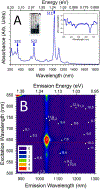Orthogonal Determination of Competing Surfactant Adsorption onto Single-Wall Carbon Nanotubes During Aqueous Two-Polymer Phase Extraction via Fluorescence Spectroscopy and Analytical Ultracentrifugation
- PMID: 39444379
- PMCID: PMC11494907
- DOI: 10.1021/acs.jpcc.4c02568
Orthogonal Determination of Competing Surfactant Adsorption onto Single-Wall Carbon Nanotubes During Aqueous Two-Polymer Phase Extraction via Fluorescence Spectroscopy and Analytical Ultracentrifugation
Abstract
A combination of analytical ultracentrifugation (AUC) and fluorescence spectroscopy are utilized to orthogonally probe compositions of adsorbed surfactant layers on the surface of (7,5) species single-wall carbon nanotubes (SWCNTs) under conditions known to achieve differential partitioning in aqueous two-phase extraction (ATPE) separations. Fluorescence emission intensity and AUC anhydrous particle density measurements independently probe and can discriminate between adsorbed surfactant layers on a (7,5) nanotube comprised of either of two common nanotube dispersants, the anionic surfactants sodium deoxycholate and sodium dodecyl sulfate. Measurements on dispersions containing mixtures of both surfactants indicate near total direct exchange of the dominant surfactant species adsorbed to the carbon nanotube at a critical concentration ratio consistent with the ratio leading to partitioning change in the ATPE separation. By conducting these orthogonal measurements in a complex environment reflective of an ATPE separation, including multiple surfactant and polymer solution components, the results provide direct evidence for the hypothesis that it is the nature of the adsorbed surfactant layer that primarily controls partitioning behavior in selective ATPE separations of SWCNTs.
Keywords: SWCNT; Single-wall carbon nanotube; analytical ultracentrifugation; aqueous two-phase extraction; separation.
Figures






References
-
- He X; Hartmann NF; Ma X; Kim Y; Ihly R; Blackburn JL; Gao W; Kono J; Yomogida Y; Hirano A; et al. Tunable room-temperature single-photon emission at telecom wavelengths from sp3 defects in carbon nanotubes. Nat. Photonics 2017, 11 (9), 577–582. DOI: 10.1038/nphoton.2017.119. - DOI
-
- Kim M; Chen C; Wang P; Mulvey JJ; Yang Y; Wun C; Antman-Passig M; Luo H-B; Cho S; Long-Roche K; et al. Detection of ovarian cancer via the spectral fingerprinting of quantum-defect-modified carbon nanotubes in serum by machine learning. Nat. Biomed. Eng 2022, 6 (3), 267–275. DOI: 10.1038/s41551-022-00860-y. - DOI - PMC - PubMed
Grants and funding
LinkOut - more resources
Full Text Sources
